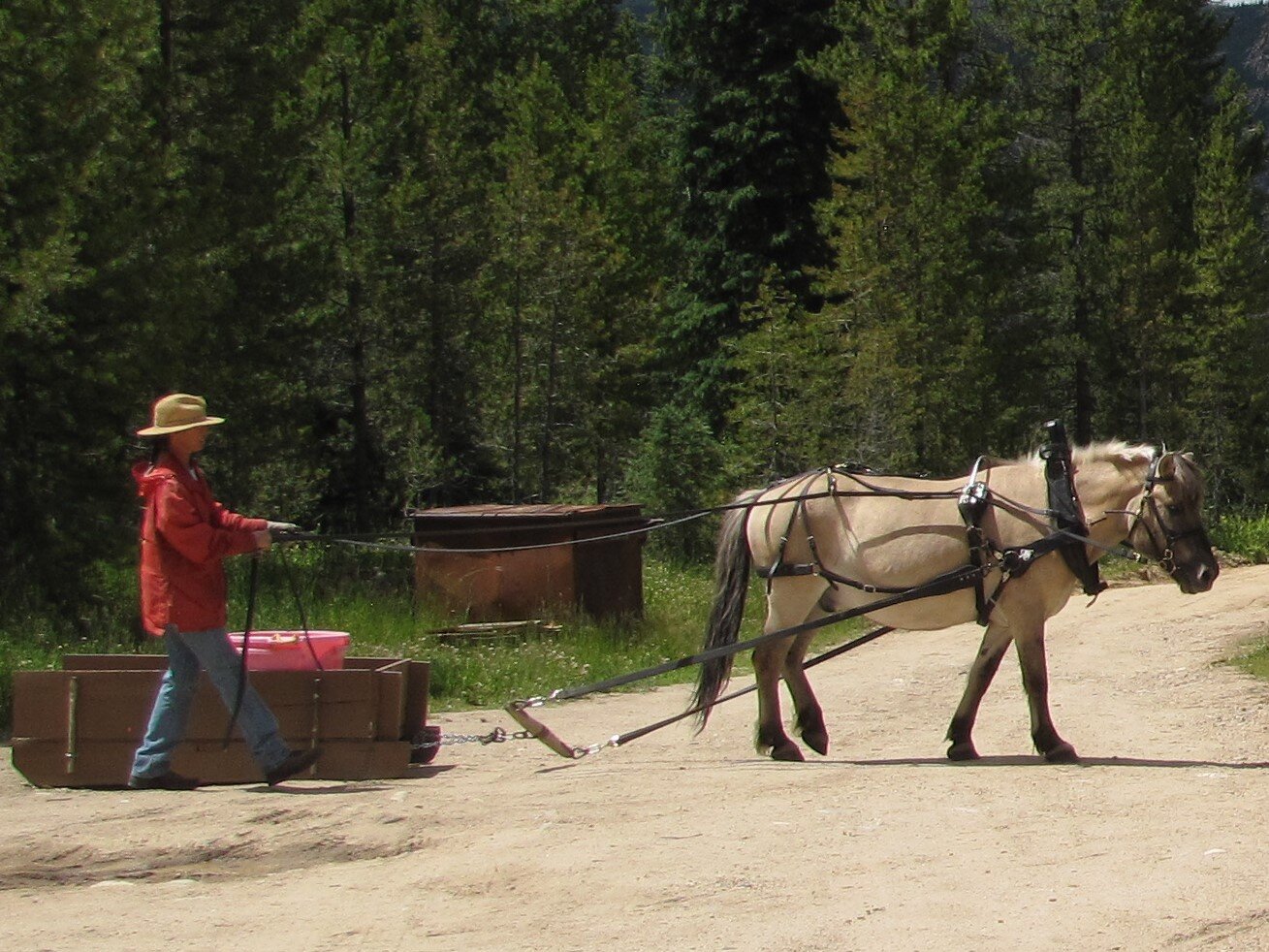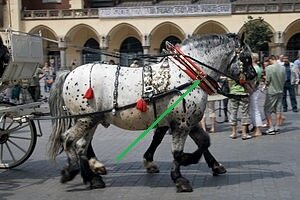In a recent article on the Fell Pony shoulder, I suggested that a well laid back shoulder requires special consideration when it comes to harness adjustments. My colleague Doc Hammill and I have written an entire book on harness, so I will obviously be brief here compared to that full treatment of the subject. I particularly want to address, though, ideal angle of draft and point of draft. In the discussion that follows, I’m assuming collar-type harness rather than breast-strap-type harness.
Norwegian harness fixes the angle of draft at the ideal
In my opinion, the ideal angle of draft is especially important to understand when we are talking about working ponies in harness. Ponies, being smaller, need to be given every opportunity to work efficiently, transferring as much of their power as possible to moving the load to which they are hitched. The ideal angle of draft enables that sort of optimal transfer of power. The angle of draft is measured between the line of the collar/hames and the line of the traces that are connected to the load. The ideal angle of draft is 90 degrees, meaning the trace is perpendicular to the collar/hames.
It is interesting to me to consider Norwegian harness when thinking about ponies and work harness. Norwegian Fjord Horses are like Fell Ponies in that they have been bred for centuries to be versatile: ride/drive/draft/pack. The quality of the shoulder is critical to that versatility, which usually means laid back. To ensure the ideal angle of draft for their versatile small equines, the Norwegians designed their harness so that the trace is fixed to the collar at the ideal angle. A picture of a Norwegian harness on my Norwegian Fjord Horse is included here. I consider the Norwegian style of harness to be proof positive for the importance of ideal angle of draft when working ponies.
Trace location for ideal angle of draft is shown in green.
The next picture is from Wikipedia, and it shows a carriage horse with a more conventional collar-and-hames-type harness on a well laid back shoulder like a Fell Pony is supposed to have. Note how the collar is laying back on the shoulder bed of the horse. Then find where the trace leaves the collar/hames and note the angle that the trace makes with the collar/hames. I have drawn a green line on the photo to show the ideal angle of 90 degrees. Obviously it would be impossible to hitch anything to this horse at that ideal angle with that collar fit where it is. Instead the collar fit would need to be adjusted, using padding for instance, to bring the top of the collar forward to change the line of the trace so that the angle of draft is closer to ideal. I saw a photograph recently of a Fell Pony stallion with heavy muscling on his neck that would take the place of ‘artificial’ padding to keep the top of the collar forward while still being well-seated on his shoulder bed.
Another problem with the collar fit shown on the well laid back shoulder in the Wikipedia photo is that a hard pull on the trace could pull the collar up into the bottom of the neck where the windpipe is, potentially causing a comfort issue for the horse. It is likely that this particular hitch requires very little effort for this particular team of horses so hopefully that comfort issue never arises. (I also have an issue with this harness because it lacks breeching, so the horses have no ability to hold the vehicle back, so the teamster must brake the vehicle to keep it from running up on the horses.) With typical harness and collars and hames, the ideal angle of draft of 90 degrees can be difficult to achieve on a laid back shoulder unless the equine has adequate muscling or adjustments are made to the collar that might not be necessary on an equine with a steeper shoulder.
The ideal point of draft is also especially important to consider when dealing with a laid back shoulder. The ideal point of draft is actually a marriage of three different ideal points: one on the shoulder, one on the collar, and one on the hames. The marriage of these three points ensures the equine is able to work as safely and comfortably as possible. Doc’s and my book has an entire very long chapter on this subject, so the following discussion is just an overview.
Point of shoulder and spine of scapula approximately shown in red. These are places where bone doesn’t have much padding of muscle over it so harness needs to be kept away from them. When the trace leaves the hames, for instance, it needs to go between the two red markings.
The ideal point of draft on the equine is located such that the line of the trace falls midway between the bottom of the spine of the scapula and the upper limits of the point of the shoulder; these two anatomical features are roughly located on the picture here and are close to the surface of the skin so it’s important for the trace to run between them.
In our book, Doc shares, “In the herd of horses that Cathy and I have, there are Suffolks, Fjords, and a Welsh Pony. On the Suffolks, there is a three inch space where the trace coming off the hames should pass… On the Fjords, the area is two-and-a-half inches average top to bottom. On the Welsh Pony it’s just two inches.” (1) Clearly with ponies we have a special responsibility to locate that ideal point of draft carefully so the trace lays comfortably on our working partners.
The ideal point of draft on a collar is the thickest and widest part of the collar, but the trick is getting that part of the collar to sit correctly on the ideal point of draft of the shoulder. Then the ideal point of draft of the hames is where the trace needs to connect to the hames to lay in the narrow region described above and also ideally be on the thickest part of the collar that is over the ideal point of draft of the equine. Whew!
Where the trace attaches to the hames, circled in red, seems too high, potentially causing the trace to ride up onto the spine of the scapula.
I saw a picture of a Fell Pony working in harness recently that had a laid back shoulder with the collar laid back on it, similar to the horse at rest shown here in another Wikipedia photo. The point of attachment of the trace on the hames seems high, possibly causing the trace to ride up onto the spine of the scapula and potentially cause injury. That high point of attachment on the hames can also possibly pull the collar up into the bottom of the neck as described above, with that laid back shoulder making this more of a possibility due to its impact on the angle of draft as described above. Most hames have very little if any ability to adjust the attachment point, so often people make do with what they have, hopefully paying close attention so there are no adverse effects on their working partners.
Doc concluded our chapter on the elusive ideal point of draft by saying, “The ideal point of draft is an anatomical and kinetic balance point in the area of the shoulder of the equine. While the ideal point of draft can differ from equine to equine, the point of draft on a particular equine remains constant. It is the point of draft on the collar and most importantly the fit of the collar and the point of draft on the hames that must be monitored and adjusted to ensure our equines’ comfort.” (2) It has been my experience that equines bred specifically to work in harness tend to have steeper shoulders than the ideal versatile Fell Pony shoulder. Therefore, when we work ponies with their laid back shoulders suitable to a wide range of activities, we have a special responsibility to fit their harness so that they can work efficiently, comfortably, and safely.
Morrissey, Jenifer. Harness Lessons with Doc Hammill and Friends, 2013, p. 85.
Morrissey, p. 97
(c) Jenifer Morrissey, 2020
The information here is a small subset of the crucial considerations when fitting harness on equines. Learn more in my book Harness Lessons with Doc Hammill and Friends, available internationally by clicking here or on the book cover.




